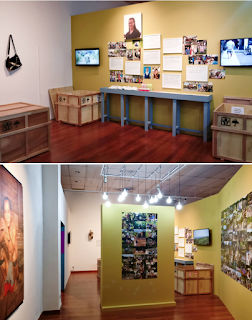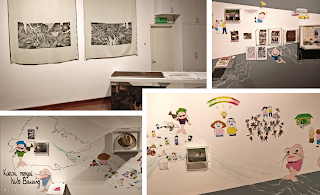KL Biennale (V): Cerita BELAS (AHistoric) Stories of Love
When the inaugural KL Biennale’s theme "Belas/ Be Loved” was revealed, cynics deride it as fatuously sanguine and bereft of ideology, as compared to other international biennales. Curator Faizal Sidek remarks in an interview, “(m)ost biennales held around the world revolve around lofty themes that the normal man in the street wouldn’t be able to identify with. We wanted to be different (…) The concept originated from Professor Hasnul Jamal Saidon…” In late 2016, Hasnul (with the National Art Gallery) initiated an outreach program “gemaBELAS”, in which “Belas can contribute in exploring the healing potentials of creative practice.” How much of that noble intention carries over to this biennale is not clear, although Hasnul is in the selection committee.
 |
| Installation snapshot of Siti Zainon Ismail – Rumah Waris Uwan (2013) and Kasih Bonda Kampung Paya Kami (2008/2015) |
Single-word non-“lofty” biennale themes are not uncommon, as one looks across the Causeway. For its inaugural event in 2006, C.J.W.-L. Wee wrote that “(t)he challenging nature of the Singapore Biennale’s theme (“Belief”), at one level a seemingly universal and global topic, actually escapes the grasp of (secularist) transnational, postcolonial and contemporary cultural theory…” While I appreciate the intent to engage an imagined public, the organizer’s posturing that we are different is off-putting. This difference manifest in the first exhibit I encountered in this biennale – one red room with the silhouette of a cat framing its entrance. Not an animal lover, the story of a saved street cat told through murals and amateurish videos, left me bewildered of its inclusion into this landmark exhibition of contemporary art.
 |
| Installation snapshots of Ahmad Sanuri Zulkefli – Merah (2017) |
‘Merah’ is a segment from "Stories of Love”, a exhibition category that functions as an “entry point for the audience to experience and appreciate the stories about love…” These segments are typically collaborations with non-artists, and highlight acts of empathy. Some are staged poorly, like the room-sized Ismail Hashim tribute within Galeri 3B. Nonetheless, the results are rewarding when done right, an example being ‘A Row of Beautiful Smiles’ in Galeri 2B. The latter is a collection of household items and photographs, which documents livelihood at a Penan community. In the video ‘Thank You Mr. Tan’, a girl narrates the contributions by artist Tan Wei Kheng to her locale. The acknowledgement is heartfelt, and one assumes that Wei Kheng’s committed engagement contributes to his stunning painted portraits of indigenous people, environs, and objects.
 |
| Installation snapshots of ‘A Row of Beautiful Smiles’ |
Another enriching exhibit is ‘Kanou Moung Hilo Bawang’ (‘Let’s Go to The River’ in Dusun), which greets visitors into Galeri Tun Razak. The installation depicts “(t)he efforts to improve the condition of Sungai Moroli (that) were initiated by the late Jefferin Majangki. Known as the father of tagal, he introduced the tagal system to the Department of Fisheries in Sabah.” I learn that Tagal is a practice to stop fishing activities and promote marine biodiversity, which has since contributed to new eco-tourism activities along river streams in Ranau. Bubble-shaped depictions by Jerome Manjat, overlay a background of sinuous forms by Long Thien Shih, who facilitated the creation (together with Lai Chan Shiang) of two woodcut prints relating to this topic, together with the students and teachers from SMK Bandar Baru Sentul.
 |
| Snapshot of Tan Hui Koon speaking in front of: Jerome Manjat – Okon Nopo Itikou Isai Po’Di (Kalau Bukan Kita, Siapa Lagi) (2017); and Long Thien Shih – Water: The Source of Life (2017) [picture from klbiennale Instagram page, in post dated 10th November 2017] |
This is the same school where “Gerakan Seni” happened, and one can imagine only positive exposure for schoolchildren, who worked with local artists to create visual entry points for meaningful initiatives. Curator Tan Hui Koon also maximized the installation for the subsequent exhibits that feature fish/water/rocks, resulting in a coherent display at the beginning of this gallery. While not all “Stories of Love” were presented successfully – and wall texts describing love and hope made me cringe – the collaboration with non-artists is a commendable effort. It is unfortunate that these segments do not strike me as obviously demarcated within exhibition spaces (I cannot recall whether “Cracks in the Wall” qualifies as a Cerita Belas, for example), which otherwise would help sceptics look harder beyond the potentially inane biennale theme. Gema Belas!
 |
| Installation snapshots of “Kanou Moung Hilo Bawang’” |
“Cakap terus-terang je la ya. Sebab kita ni sakit! dan selalunya suka sgt 'cari penyakit' (termasuk yg tulis ni). Ya, sebab tahap kesihatan mental kita kritikal walaupun ramai taknak mengaku. Ada yg suka tunding pd org lain, atau hanya pandai komen, ulas, membahan, men'spin' dan viralkan kes2 mental tak sihat ni saja, selalunya dari satu sumber saja dan tanpa usul periksa. Masalah kesihatan mental menyerang semua org tanpa mengira label di dahi - budak2, org2 muda, tua, org seni, org sains, ahli2 politik, org2 yg mengaku alim, pemimpin, pendidik, pelajar universiti, dll.Kita semua amat perlu 'saling-menyembuh', sekarang, setiap sekarang. Belas itu menyembuh. Belasah itu membunuh. Ihsan dan memaafkan itu menyembuh. Jomla gemakan belas, bukan belasah. Moga kita semua sejahtera dlm dakapan kasih dan belas. Sentiasa osem, anda semua!”
– Blog post addressing “Kenapa #gemabelas2017?” by Hasnul Jamal Saidon, dated 4th June 2017
 |
| Installation and detail snapshots of Shamsu Mohamad – Earth Story (2017) |
Comments
Post a Comment